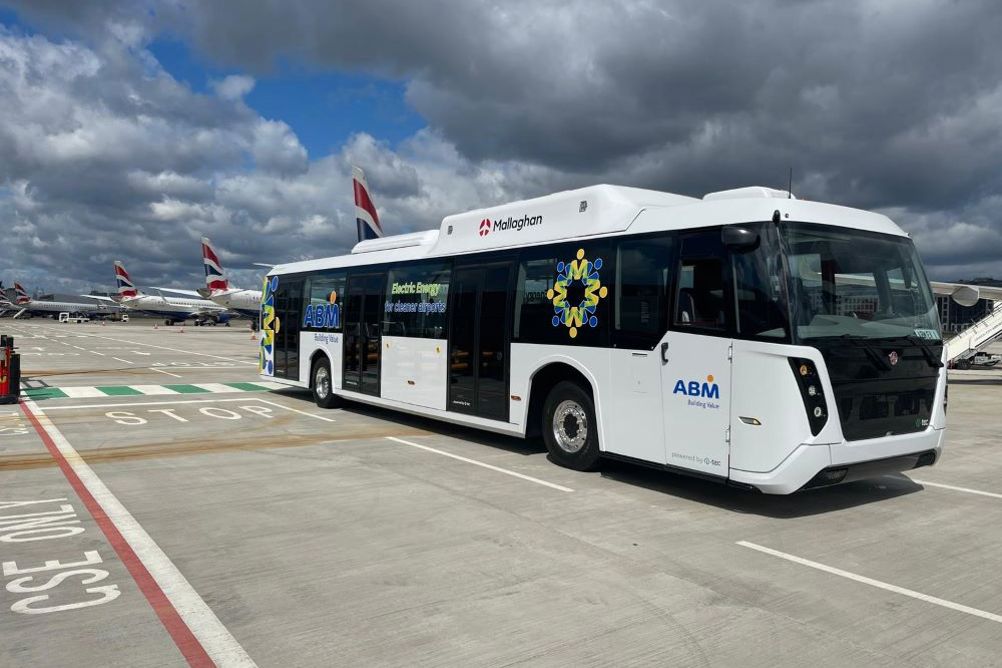
Aviation must reduce its carbon footprint, and electrification of ground vehicles is one way of doing that. Mallaghan delivered its first diesel-powered bus to Ryanair in 2019 as the launch customer for 32 units in operation in Spain and Poland but since then, it has become clear that diesel is the past and electric is the clean source of power.
Presenting the all-electric Árbus i-tec bus at Gatwick Airport on 25 November, Owen McKenna, Sales Director of Mallaghan explained more about the decision. He said: “We can see that the industry is totally pivoting towards sustainability and part of that is the electrification of GSE. Earlier this year we delivered our first electric bus to ABM, it’s been on trial since June. We put a lot of good mileage on it and achieved good data. ABM have been a good partner, working together to develop the product.”
As the industry moved towards sustainability, Mallaghan launched its subbrand, i-tec to electrify all of its GSE. Next year, Mallaghan will stop manufacturing diesel airport buses for two reasons, McKenna explained.
“The majority of the demand is for electric buses and secondly, the diesel engine we’re using is changing, there’s a new Euro norm coming out so it would require a lot of R&D so we’re putting our focus and resources into electrification,” he said.
Tadej Podgrajšek, Regional Sales Manager for Mallaghan was available to provide more technical information. Ryanair has been happy with the diesel-powered buses but electric is the future, and Podgrajšek said being the first to make the move will be a good move for Mallaghan. Across Europe, governments are providing incentives for electric equipment, such as buses.
He said: “In the long-run it’s definitely more economical and better for the environment. We have done calculations for the UK, with a fleet of five diesel buses driving 60 kilometres a day, we are saving between 88 and 140 tonnes of CO2 a year along with diesel consumption. When comparing electricity and diesel consumption, there is a saving of 86%.”
The bus’s body is fully galvanised for support against corrosion and it is easier to repair if it suffers damage. Mallaghan estimates the bus’s lifetime is 25 years. The inside can be customised to customer requirements, such as providing ambient lighting.
Three models are available, the one on display at Gatwick carries 100 passengers, the next size up is for 110 and the largest for 118. The electric motor has 250kW of power, each axle has ABS and the buses have regenerative braking, restoring a significant amount of energy to recharge the batteries. The software system also lets customers make required modifications, giving them flexibility depending on the airport setup.
Podgrajšek said flexibility for battery configuration is Mallaghan’s biggest advantage. He said a solution can be found for small regional airports, major hubs and anything in between because Mallaghan can offer between one and five battery packs, giving power between 60kW and 315kW.
Most UK and European airports would require two or three batteries, with two offering around 90 kilometres of range and a bigger one reaching nearer 200 kilometres.
“The idea that we are trying to promote with our buses is that you can start the bus in the morning, drive all day using the air conditioning or heating, and at the end of the day just plug it in and do the same the next day,” he said.
More batteries can be added if required, up to four packs and a fifth one can go inside the passenger compartment but in front of the front axle so as not to get in their way.
Charging time depends on the number of batteries and the strength of the charger. With 32 amps, the charging time from zero to 100% would be around six and a half hours but as customers are more likely to charge from around 40%, four hours will be required.
Electrical demands are small so there is no need for expensive infrastructure upgrades as it uses a standard five pin plug and can receive a slow charge overnight.
The battery is lithium metal polymer, which is solid with no liquid inside and no need for heating or cooling. Mallaghan can offer a warranty for the battery of 10 years, the longest on the market. The batteries are much denser so can provide higher kilowatt hours at the same weight than rivals.
With no engine or gearbox, maintenance is much lower than diesel alternatives. Mallaghan have done the sums comparing electricity costs to diesel, and the electric option quickly pays for itself.
“Comparing diesel competitors to using two or three battery packs, the break even point would be around year six. In the long run, it makes economic sense,” said Podgrajšek.






